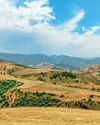
Fiction can, in our imagination, create a stronger impress of actuality than tangible reality itself. And, consequently, we may find it difficult to tell one from the other. Such is the case of the Marabar Caves. It’s obvious from the very first sentence that the Marabar Caves were the focal point of A Passage to India, the novel on the muddle of race relations that E. M. Forster had written exactly one hundred years ago. They resonate through the narrative, the conversations and thought processes of its characters like the echoes that rebound within the caves’ dark, cavernous interiors. It is an acoustic reality that booms through the novel.
It wasn’t until months after my visit to Bihar last December that I discovered that even friends who taught English literature in universities had no idea that the impulse behind those fictional Marabar Caves came from a network of caves known as Barabar in what once were the badlands of the Makhdumpur region in the state’s Jehanabad district—a territory where banditry and Naxalite insurgents had a free run. I too didn’t know the Barabar Caves even existed.
It was close to Christmas, and so, expecting the dreaded Bihar cold wave, we—my young nephew Somnath was my travelling companion—had armed ourselves with the heaviest jackets and thermals. It turned out to be quite otherwise, however, and I was forced to peel off all my coverings. Bihar upended all our expectations. The rough-hewn, untrammeled beauty of nature—low-lying hills leaning against the horizon, miles of rolling grassland with palm trees standing sentinel, and acres of cultivated land—adequately compensated for the occasional rough patches on the roadways. Boulders both small and gigantic were strewn all along.
This story is from the {{IssueName}} edition of {{MagazineName}}.
Start your 7-day Magzter GOLD free trial to access thousands of curated premium stories, and 9,000+ magazines and newspapers.
Already a subscriber ? Sign In
This story is from the {{IssueName}} edition of {{MagazineName}}.
Start your 7-day Magzter GOLD free trial to access thousands of curated premium stories, and 9,000+ magazines and newspapers.
Already a subscriber? Sign In

Demonstrators by Krishna Reddy
1968 Multicolour viscosity, Print on paper

Notes from Grief Camp
Every summer, more than a hundred children come together to spend a weekend swimming, climbing and canoeing. They also learn to deal with death

Six Places Cheese Lovers Should Visit
Ancient caves, monasteries, and other must-sees for fromage fans

THE LAND OF SUPERCEN TENARIANS
A remote region of Azerbaijan claims to have many extremely long-lived residents. What is their secret, or is it just a myth?

The Whistle Blowers
My grandparents had a distinctive way of communicating

"THE NEXT AIRCRAFT WILL CRASH ON LANDING"
THE JET WAS ALMOST OUT OF FUEL. THE PILOTS' ONLY OPTION WAS A MANOEUVRE NO ONE HAD EVER ATTEMPTED.

The Secrets in our Genes
Genomic sequencing tests can reveal much about your unique physiology. But are they worth it?

GOOD NEWS FROM AROUND THE WORLD
MENTAL HEALTH When her son was arrested last year, Tambudzai Tembo's mind went to dark thoughts of suicide.

Into the Inferno
A gas station owner has seconds to react when a car crashes into a gas pump

THE CLIMATE CHANGERS
THESE PLACES ARE LEADING THE WAY TO A FUTURE FREE OF FOSSIL FUELS